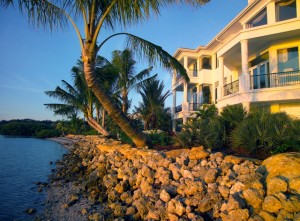RIPRAP DOESN’T DESERVE A BAD WRAP.
Q: I think it’s a bunch of rubbish (or should I say rubble) that our landscape architect is recommending riprap for our seawall. To me, riprap looks like a bunch of dirty rocks, and I can hardly believe I’m expected to pay for this stuff. Seriously?
A: It’s easy to rip riprap. After all, the broken stone pieces are rough and angular — nothing like polished Mexican Beach Pebble or Indian Creek Rock.
But when it comes to limiting soil erosion in Florida, you won’t find a better choice. Made of quarried limestone or granite, riprap ranges in size from 6”-12” all the way up to large boulders. You’ll see it on coastlines, around lakes and ponds, at the base of bridge pilings and many other places.
Like you, most people think riprap is just a big pile of rocks Mother Nature happened to spill on the ground, when it’s actually been positioned intentionally to hold down ground or sand.
And that’s precisely why ArtisTree likes riprap so much. It can be designed to look like a very natural and beautiful part of your property while secretly protecting it from erosion.
Case in point: Check out this breathtaking landscape we designed using various sizes of riprap. The homeowners loved how their waterfront property was transformed into a functional work of art. As you can see, a “bunch of rocks” really can increase the beauty and value of your property. We hope you give your landscape architect the green light and move ahead with his recommended design.

Category Landscape Maintenance, Turf Care
Tagged with: erosion protection, retaining walls, riprap


